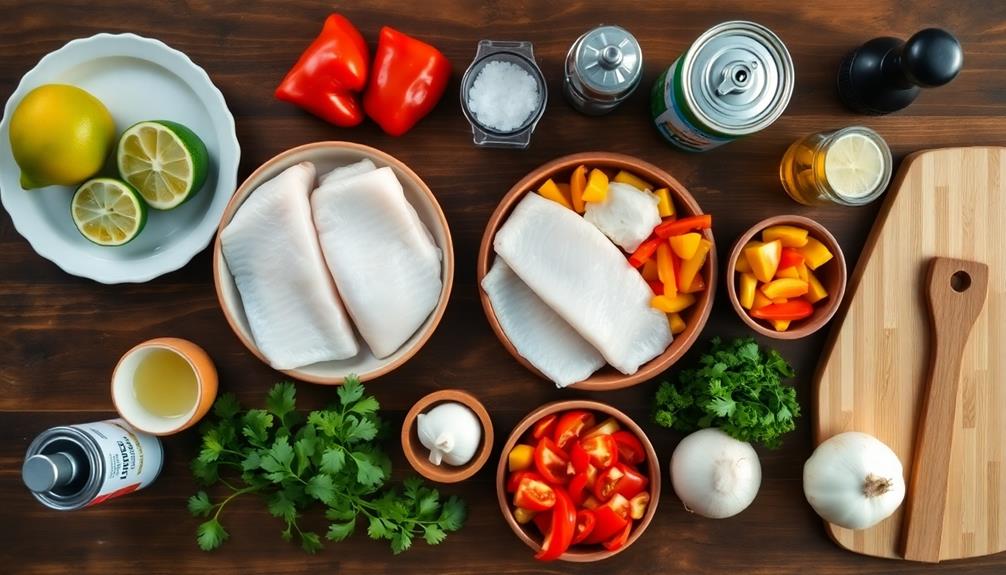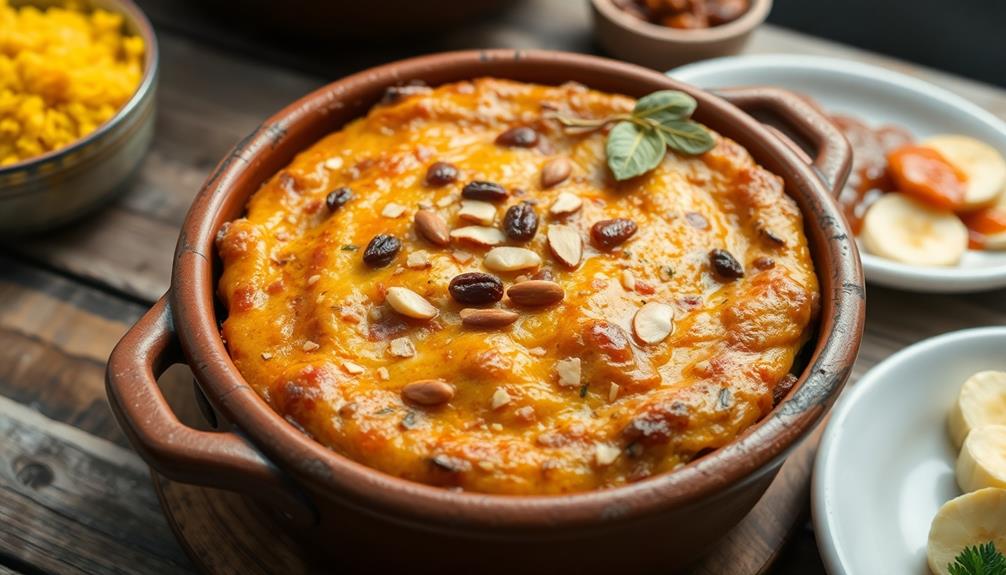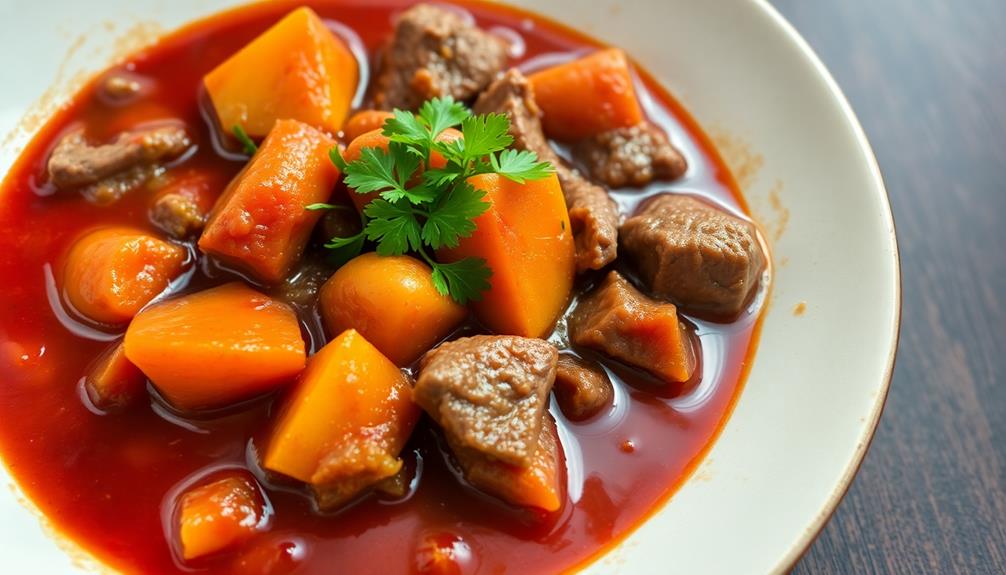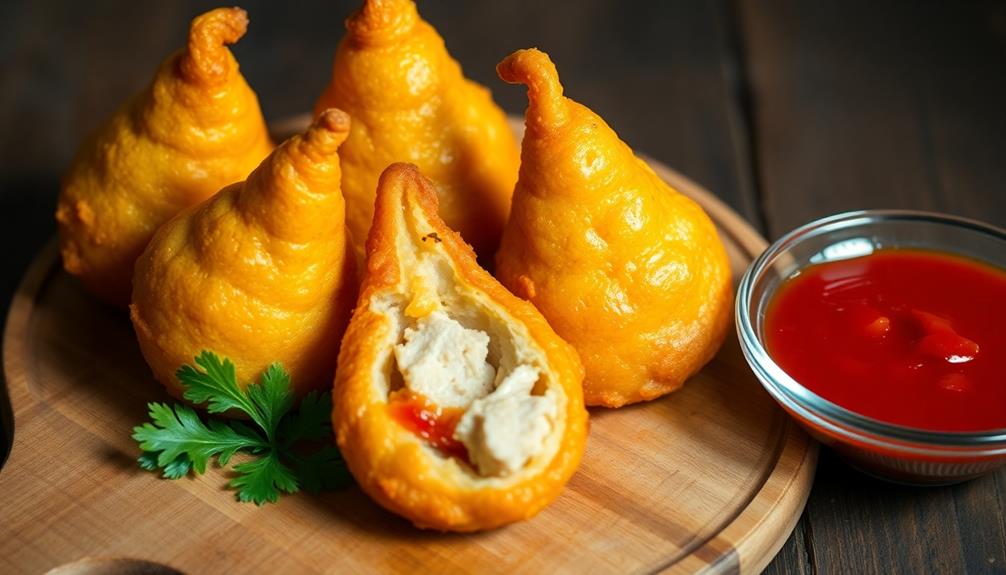Moqueca is a mouthwatering Brazilian fish stew that'll make your taste buds dance! You'll love its creamy coconut milk base, tangy tomatoes, and zesty lime juice. This coastal dish combines fresh white fish with colorful bell peppers, onions, and garlic. As it simmers, the flavors meld together, creating a rich, orange-colored stew that's bursting with taste. You can serve it hot with fluffy white rice or farofa for an authentic experience. Moqueca's history is as diverse as its ingredients, reflecting Brazil's cultural melting pot. If you're curious about the secrets behind this delicious dish, there's so much more to discover!
Key Takeaways
- Moqueca is a traditional Brazilian fish stew originating from coastal regions, particularly Bahia.
- Key ingredients include white fish, coconut milk, tomatoes, peppers, and palm oil.
- The dish reflects Brazil's cultural diversity, blending indigenous, African, and Portuguese influences.
- Moqueca is typically served hot with white rice and garnished with fresh cilantro.
- Two popular regional variations are moqueca baiana from Bahia and moqueca capixaba from Espírito Santo.
History
Moqueca's origins can be traced back centuries to Brazil's coastal regions. You'll find that this delicious fish stew has roots in both indigenous and African cooking traditions. As Portuguese settlers arrived in Brazil, they brought their own culinary influences, adding to the dish's rich history.
In the early days, moqueca was cooked in clay pots by native Brazilians. These pots gave the stew its unique flavor and texture. When African slaves were brought to Brazil, they introduced palm oil and coconut milk to the recipe, creating the creamy base we know today.
You might be surprised to learn that moqueca has different versions depending on the region. In Bahia, you'll find a version called "moqueca baiana" that's known for its vibrant orange color from dende oil. In Espírito Santo, they make "moqueca capixaba" without the coconut milk. Both are equally delicious!
Over time, moqueca has become a beloved national dish. It's a testament to Brazil's diverse cultural heritage and the way food can bring people together. When you taste moqueca, you're experiencing centuries of history in every spoonful!
Recipe
Moqueca is a traditional Brazilian fish stew that originated in the state of Bahia. This flavorful dish combines fresh white fish, coconut milk, and aromatic vegetables to create a rich and satisfying meal. The key to a perfect moqueca lies in the balance of flavors and the use of high-quality, fresh ingredients.
While there are several regional variations of moqueca, the most popular version is the Moqueca Baiana, which incorporates palm oil (dendê) and coconut milk. This recipe focuses on that style, offering a taste of authentic Brazilian coastal cuisine that can be easily prepared in your own kitchen.
- 2 lbs white fish fillets (such as cod, halibut, or sea bass), cut into chunks
- 1 lime, juiced
- 2 cloves garlic, minced
- 1 onion, sliced
- 1 red bell pepper, sliced
- 1 yellow bell pepper, sliced
- 2 tomatoes, chopped
- 1 cup coconut milk
- 2 tablespoons palm oil (dendê)
- 1 tablespoon olive oil
- 2 tablespoons cilantro, chopped
- Salt and pepper to taste
To prepare the moqueca, start by marinating the fish in lime juice, garlic, salt, and pepper for about 30 minutes. In a large, heavy-bottomed pot, heat the olive oil and sauté the onions and bell peppers until softened.
Add the tomatoes and cook for a few more minutes. Layer the marinated fish on top of the vegetables, then pour in the coconut milk and palm oil. Cover and simmer gently for about 15-20 minutes, or until the fish is cooked through. Avoid stirring to keep the fish pieces intact. Garnish with chopped cilantro before serving.
For the best results, use the freshest fish available and adjust the cooking time based on the thickness of your fish fillets. If palm oil is unavailable, you can substitute it with a mixture of paprika and additional olive oil to achieve a similar color and flavor profile.
Serve the moqueca hot, accompanied by white rice or farofa (toasted manioc flour) for an authentic Brazilian dining experience. If you really want to impress your guests, consider preparing a traditional Brazilian escondidinho recipe as a side dish. This savory casserole typically layers mashed yuca with a filling of shredded meat, such as sun-dried beef or jerked beef, and melted cheese. The combination of flavors and textures will truly transport you to the heart of Brazil.
Cooking Steps
You're about to embark on a culinary adventure with moqueca!
First, you'll heat oil in a pan and add your seafood and veggies, creating a colorful base for your dish.
Next, you'll pour in coconut milk and sprinkle in spices, letting everything simmer until the fish is perfectly cooked.
Step 1. Heat Oil in Pan

To begin the cooking process, heat a large, heavy-bottomed pan or Dutch oven over medium heat.
Once your pan is warm, it's time to add some oil! Pour in about two tablespoons of vegetable oil or coconut oil, whichever you prefer.
You'll want to swirl the pan gently to make sure the oil coats the bottom evenly.
Now, here's the fun part: watch the oil closely as it starts to shimmer and dance! This is how you'll know it's getting hot enough.
You might even see tiny ripples forming on the surface – that's a good sign!
If you're feeling brave, you can carefully flick a tiny drop of water into the pan. If it sizzles and evaporates right away, your oil is ready for action!
Step 2. Add Seafood and Vegetables

With the oil hot and ready, it's time to add your seafood and vegetables to the pan. First, gently place your chosen seafood into the hot oil. You can use fish, shrimp, or a mix of both – whatever you like best! Let them sizzle for a minute or two, then carefully flip them over.
If you're looking for a healthy twist, consider incorporating some of the beneficial foods for gout management into your dish, such as some fresh vegetables that can enhance both flavor and nutrition.
Next, it's veggie time! Toss in your colorful bell peppers, juicy tomatoes, and fragrant onions. Don't forget to add some minced garlic for extra flavor. Give everything a good stir, making sure the veggies are evenly spread out in the pan.
You'll start to smell the amazing aroma of the seafood and vegetables cooking together. As everything cooks, you'll notice the vegetables softening and the seafood turning a beautiful golden color.
This is when the magic happens! The flavors are starting to blend, creating that delicious Moqueca taste you've been waiting for. Keep an eye on your pan, stirring occasionally to make sure nothing sticks.
In just a few minutes, your seafood and vegetables will be perfectly cooked and ready for the next step in your Moqueca adventure!
Step 3. Add Coconut Milk and Spices

The sizzling pan of seafood and vegetables is now ready for the next crucial step. It's time to add the creamy coconut milk and aromatic spices that'll transform your dish into a true moqueca.
Pour in a generous amount of coconut milk, watching as it mingles with the other ingredients, creating a luscious sauce. Now, let's spice things up!
Grab your favorite spices – don't be shy! Sprinkle in some paprika for a touch of sweetness and color. Add a pinch of red pepper flakes if you're feeling adventurous. Don't forget the cilantro; its fresh, zesty flavor will make your moqueca sing.
Stir everything gently, making sure the coconut milk and spices coat all the seafood and veggies evenly. As you mix, you'll notice the enticing aroma filling your kitchen. It's like a preview of the delicious meal to come!
Let the mixture simmer for a few minutes, allowing the flavors to meld together. Keep an eye on it, giving it an occasional stir to prevent sticking. Your moqueca is almost ready to serve!
Step 4. Simmer Until Fish Is Cooked

Now that your moqueca is simmering with all its flavorful components, it's time to focus on cooking the fish to perfection. Gently lower the fish pieces into the simmering broth, making sure they're mostly submerged.
Don't worry if some parts stick out a little – the steam will help cook them too!
Cover the pot with a lid and let the moqueca simmer for about 10 to 15 minutes. You'll know the fish is done when it's opaque and flakes easily with a fork.
Be careful not to overcook it, or you'll end up with tough, rubbery fish. While it's simmering, resist the urge to stir too much – you don't want to break up those beautiful fish pieces!
If you're using different types of seafood, remember that they might've different cooking times. Shrimp, for example, cook faster than most fish fillets.
You can add quicker-cooking seafood towards the end of the simmering time to ensure everything's perfectly cooked. Once your fish is done, your moqueca is ready to serve!
Get ready for a delicious, aromatic feast that'll transport you straight to the beaches of Brazil.
Step 5. Garnish With Fresh Cilantro

Just before serving, you'll want to add a final touch of freshness to your moqueca. Grab a handful of fresh cilantro and give it a quick rinse under cool water. Gently pat it dry with a clean kitchen towel or paper towels.
Now, it's time to chop! Hold the cilantro bunch together and use a sharp knife to finely chop the leaves and tender stems. Don't worry if you're not a pro – a rough chop will do just fine!
Sprinkle the chopped cilantro generously over the top of your steaming moqueca. The vibrant green leaves will create a beautiful contrast against the rich, orange-colored stew.
As you scatter the cilantro, you'll notice its fresh, citrusy aroma wafting up, adding an extra layer of excitement to your dish. The cilantro not only looks pretty but also adds a burst of flavor that complements the spices in your moqueca.
It's like adding a little culinary confetti to celebrate your cooking success! Your moqueca is now ready to be served and enjoyed by all.
Final Thoughts
Moqueca stands out as a true gem of Brazilian cuisine, offering a perfect balance of flavors and textures. You'll love how the creamy coconut milk blends perfectly with the tangy tomatoes and zesty lime juice. It's a dish that'll make your taste buds dance with joy!
When you're cooking moqueca, remember that patience is key. Let the flavors meld together as the stew simmers, and you'll be rewarded with a truly delicious meal.
Don't forget to serve it with some fluffy white rice to soak up all that yummy sauce.
Moqueca isn't just tasty; it's also a great way to explore Brazilian culture through food. Each spoonful tells a story of the country's rich culinary heritage.
Frequently Asked Questions
Is Moqueca Spicy?
Is it spicy? Well, that depends on how you prepare it. You'll find some versions can pack a fiery punch, while others are milder. It's customizable, so you can adjust the spice level to your liking.
Can Moqueca Be Made Vegetarian?
You can definitely make a vegetarian version! Simply swap out the seafood for your favorite veggies. Try using eggplant, mushrooms, or hearts of palm. You'll still get that rich, flavorful stew you're craving.
What's the Best Side Dish to Serve With Moqueca?
You'll want to serve a side dish that complements the rich flavors. Try white rice, farofa, or pirão. These traditional accompaniments soak up the delicious broth. Don't forget some crusty bread for dipping!
How Long Does Leftover Moqueca Last in the Refrigerator?
You'll want to consume your leftovers within 3-4 days for best quality and safety. Store them in an airtight container in the fridge. Reheat thoroughly before eating, and if it smells off, don't risk it.
Are There Regional Variations of Moqueca in Brazil?
You'll find regional variations of this dish across Brazil. In Bahia, you'll encounter moqueca baiana with palm oil and coconut milk. Espírito Santo's version, called moqueca capixaba, uses annatto oil instead of palm oil.










